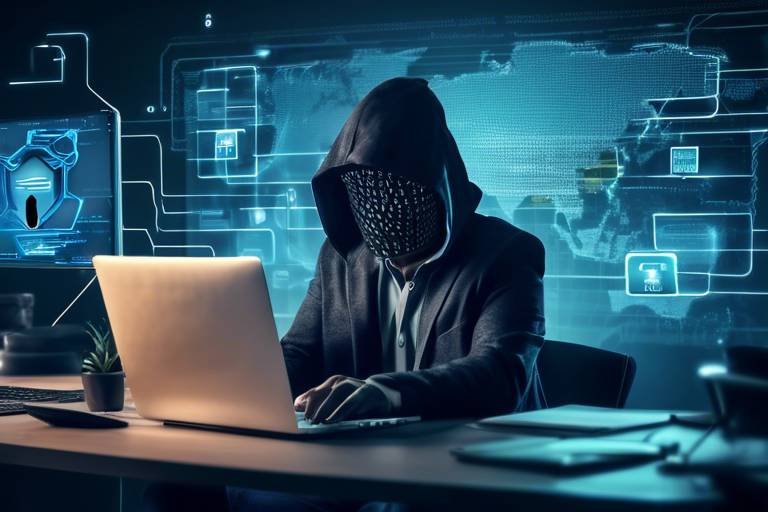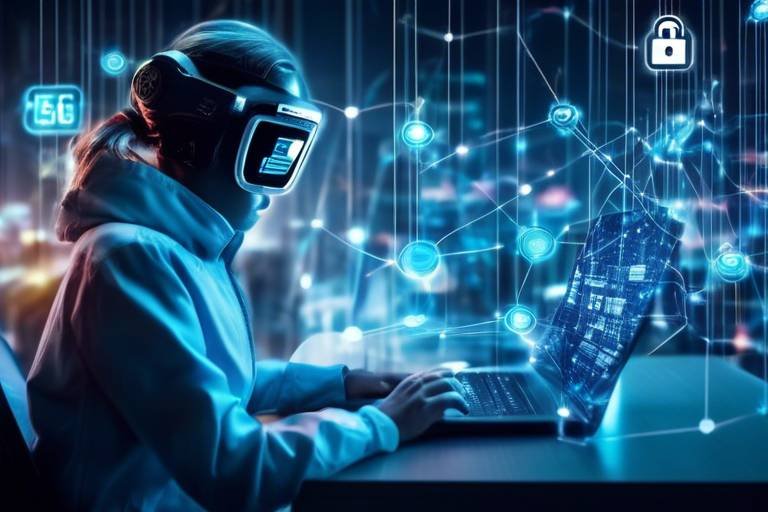Cybersecurity Risks in Remote Working Environment
In today’s fast-paced world, the shift to remote work has transformed how businesses operate. While this flexibility offers numerous benefits, it also opens the door to a myriad of cybersecurity risks. As employees work from various locations, the traditional office security measures become less effective, creating a complex landscape that organizations must navigate. Understanding these risks is not just essential; it’s a necessity for maintaining the integrity of sensitive data and the overall operational health of a business.
Imagine working from your cozy living room, sipping coffee, and feeling secure. Now, picture a cybercriminal lurking in the shadows, ready to exploit any weakness in your digital armor. The reality is that remote work environments can be a hacker's playground if proper precautions aren’t taken. This article will delve into the various vulnerabilities that remote workers face, the potential threats looming in the digital space, and practical strategies to safeguard sensitive information.
First and foremost, let’s take a closer look at what constitutes cybersecurity risks. These risks range from data breaches to identity theft, and they can occur through various channels, including email, unsecured networks, and even personal devices. Recognizing these risks is the first step in developing effective strategies to protect your data and maintain operational integrity.
It’s important to acknowledge that the remote work environment is inherently different from a traditional office setup. Employees are often using personal devices, connecting to public Wi-Fi, and accessing company data from various locations. This decentralized approach can create vulnerabilities that cybercriminals are eager to exploit. The need for robust cybersecurity measures is more critical than ever, as organizations must adapt to these new challenges.
In the following sections, we will explore common threats faced by remote workers, including phishing attacks, malware risks, and the importance of securing remote work environments. By understanding these threats, organizations can implement targeted security measures that not only protect their data but also empower employees to work confidently from anywhere.

Understanding Cybersecurity Risks
In today's digital landscape, where remote work is becoming the norm, it is crucial to understand the various cybersecurity risks that can jeopardize both personal and organizational data. The shift to working from home has opened up a plethora of vulnerabilities that cybercriminals are eager to exploit. From unsecured Wi-Fi networks to outdated software, the risks are numerous and can have devastating consequences. So, what exactly are these risks?
Cybersecurity risks can be defined as potential threats that can compromise the integrity, confidentiality, and availability of information. When employees work remotely, they often rely on personal devices and home networks, which may not have the same security measures in place as corporate environments. This creates a perfect storm for cyberattacks. For instance, a simple act of connecting to an unsecured Wi-Fi network at a coffee shop can expose sensitive company data to hackers lurking in the shadows.
Understanding these risks means recognizing the different types of threats that remote workers face. Some of the most common risks include:
- Phishing Attacks: Deceptive emails that trick employees into revealing sensitive information.
- Malware: Malicious software that can infiltrate devices and compromise data.
- Unsecured Networks: Public Wi-Fi connections that lack encryption, making data vulnerable to interception.
Moreover, the human factor cannot be overlooked. Often, employees are the weakest link in the cybersecurity chain. A lack of awareness about potential threats can lead to mistakes that put the entire organization at risk. Thus, training and education are essential components in building a robust cybersecurity strategy.
To effectively combat these risks, organizations must implement comprehensive security protocols tailored to the remote working environment. This includes adopting technologies such as Virtual Private Networks (VPNs), using strong passwords, and regularly updating software to patch any vulnerabilities. The goal is not just to react to threats but to proactively create a secure working environment that minimizes risks.
In summary, understanding cybersecurity risks in a remote working environment is the first step toward safeguarding sensitive information. By recognizing the types of threats and the vulnerabilities that come with remote work, organizations can develop targeted strategies to protect their data and maintain operational integrity. The digital world is fraught with dangers, but with the right knowledge and tools, businesses can navigate these challenges successfully.

Common Threats in Remote Work
In the ever-evolving landscape of remote work, the digital frontier presents a plethora of challenges that can jeopardize the security of sensitive information. As employees shift from traditional office environments to home offices, they become increasingly vulnerable to a variety of cybersecurity threats. Understanding these threats is not just beneficial; it's essential for any organization aiming to maintain robust security protocols.
One of the most prevalent threats in remote work settings is phishing attacks. These insidious schemes often masquerade as legitimate communications, tricking employees into revealing sensitive information such as passwords or financial details. The remote work environment provides fertile ground for these attacks, as employees may not have the same level of oversight or support as they would in an office. In fact, statistics show that remote workers are 3 times more likely to fall victim to phishing attacks than their in-office counterparts.
Another significant risk is the presence of malware. This malicious software can infiltrate devices through seemingly innocuous downloads or links. Once installed, malware can wreak havoc, stealing personal information, corrupting files, or even taking control of the infected device. The increase in personal devices used for work purposes further complicates this issue, as personal security measures may not be as stringent as those found in corporate environments. Employees must be vigilant, ensuring that they only download software from trusted sources.
Moreover, unsecured networks pose a considerable threat to remote workers. Many individuals use public Wi-Fi networks, which can be easily exploited by cybercriminals. Without proper encryption, sensitive data transmitted over these networks can be intercepted, leading to data breaches and identity theft. Organizations must educate their employees about the risks associated with public networks and encourage the use of secure connections, such as VPNs, to safeguard their data.
In addition to these threats, employees might encounter insider threats. These can come from disgruntled employees or even unintentional actions by well-meaning staff members who may inadvertently expose sensitive information. Companies need to foster a culture of security awareness, ensuring that all employees understand the importance of data protection and the potential consequences of negligence.
To summarize, the common threats in remote work environments include:
- Phishing Attacks
- Malware Risks
- Unsecured Networks
- Insider Threats
By recognizing these threats, organizations can implement targeted security measures to mitigate risks, ensuring that their sensitive information remains protected in an increasingly decentralized workplace.

Phishing Attacks
This article explores the various cybersecurity risks associated with remote work, providing insights into vulnerabilities, potential threats, and strategies for safeguarding sensitive information in a decentralized workplace.
Cybersecurity risks encompass a range of threats that can compromise remote work environments. Recognizing these risks is essential for developing effective strategies to protect data and maintain operational integrity.
Remote workers face unique threats such as phishing attacks, malware, and unsecured networks. Understanding these common threats helps organizations implement targeted security measures to mitigate risks.
Phishing attacks are prevalent in remote work settings, where employees may inadvertently reveal sensitive information. These attacks often come disguised as legitimate communications, making them particularly insidious. Imagine receiving an email that appears to be from your bank, asking you to verify your account information. It looks real, it feels real, but it’s anything but. This is the essence of phishing—tricking individuals into divulging confidential data.
Awareness and training are crucial in preventing these deceptive practices that exploit human vulnerabilities. Organizations must foster a culture of vigilance among their employees. Regular training sessions can equip staff with the knowledge to identify phishing attempts. For instance, employees should be encouraged to:
- Examine the sender's email address closely.
- Look for spelling errors or unusual phrasing.
- Never click on links or download attachments from unknown sources.
Recognizing the signs of phishing attempts can significantly reduce the risk of falling victim. Employees should be trained to spot suspicious emails and links, enhancing overall cybersecurity. By creating a checklist for identifying phishing attempts, organizations can empower their workforce to act as the first line of defense against these threats.
To effectively combat phishing, it’s vital to understand what to look for. Phishing emails often contain urgent language, prompting the recipient to act quickly without thinking. They may also include links that, when hovered over, reveal a URL that doesn’t match the supposed sender. Training employees to recognize these red flags can dramatically decrease the likelihood of successful phishing attacks.
Implementing multi-factor authentication and regular security training can help prevent phishing attacks. Organizations must prioritize these measures to safeguard sensitive data effectively. Multi-factor authentication adds an extra layer of security by requiring a second form of verification, making it much harder for cybercriminals to gain access even if they obtain a password. Additionally, regular simulated phishing exercises can help reinforce training and keep employees alert to potential threats.
Malware poses a significant threat to remote workers, often infiltrating devices through downloads or malicious links. Understanding how malware operates is vital for prevention and response strategies.
Establishing secure remote work environments is essential for protecting sensitive information. Organizations should adopt best practices and tools to enhance security measures tailored for remote operations.
Virtual Private Networks (VPNs) encrypt internet traffic, providing a secure connection for remote workers. Utilizing VPNs is a critical step in safeguarding data from potential breaches.
Keeping software up to date is crucial for security. Regular updates patch vulnerabilities, reducing the risk of exploitation by cybercriminals in remote work settings.
A phishing attack is a cybercrime where attackers impersonate legitimate organizations via email or other communication methods to steal sensitive information, such as usernames, passwords, and credit card details.
Look for signs such as misspelled words, unfamiliar sender addresses, and urgent requests for personal information. Always verify the email's authenticity before clicking on any links or attachments.
If you receive a phishing email, do not click any links or download attachments. Report it to your IT department or use the reporting feature in your email client. Delete the email immediately.
Organizations can conduct regular training sessions, provide resources on identifying phishing attempts, and run simulated phishing exercises to reinforce learning and awareness.

Identifying Phishing Attempts
In the ever-evolving landscape of cybersecurity, phishing attacks have become a common weapon for cybercriminals, particularly in remote work environments. These deceptive tactics often exploit the human element, making it essential for employees to be vigilant and well-informed. But how can one identify a phishing attempt before falling victim to it? Understanding the signs is the first step in safeguarding sensitive information.
Phishing attempts often come disguised as legitimate communications. They can appear in emails, messages, or even social media notifications. Here are some key indicators to watch out for:
- Suspicious Sender: Always check the sender's email address. Phishing emails often come from addresses that mimic legitimate sources but contain slight variations.
- Urgent Language: Phishing attempts frequently use urgent language to provoke a quick response. Phrases like "Your account will be suspended" or "Immediate action required" are red flags.
- Unusual Attachments or Links: Be wary of unexpected attachments or links. Hover over links to see the actual URL before clicking; phishing links often redirect to malicious sites.
- Generic Greetings: Phishing emails often use generic greetings like "Dear Customer" instead of your name, indicating a lack of personalization.
Recognizing these signs can significantly reduce the chances of falling prey to phishing schemes. It’s not just about spotting a suspicious email; it’s about fostering a culture of awareness and caution among remote workers. Training sessions can be incredibly effective in teaching employees how to identify these threats. Regularly updating training materials to include the latest phishing tactics ensures that everyone stays informed and alert.
In addition to training, organizations can implement tools that help identify and filter out potential phishing emails before they reach employees' inboxes. For instance, advanced email filtering systems can analyze incoming messages for known phishing characteristics, providing an additional layer of security.
Ultimately, identifying phishing attempts is about being proactive. Encourage employees to take their time when responding to emails and to always verify the authenticity of any requests for sensitive information. Just like a detective scrutinizing a crime scene, each detail can provide crucial clues to prevent a cyberattack.
Q: What should I do if I suspect a phishing attempt?
A: If you suspect a phishing attempt, do not click any links or download attachments. Report the email to your IT department or use your email provider's reporting tools.
Q: How can I educate my team about phishing?
A: Regular training sessions, simulated phishing tests, and sharing examples of recent phishing scams can help raise awareness among your team.
Q: Are there tools to help identify phishing emails?
A: Yes, there are various email filtering tools and security software that can help identify and block phishing attempts before they reach your inbox.

Preventing Phishing Attacks
Preventing phishing attacks is not just a matter of implementing software; it requires a comprehensive approach that combines technology, training, and vigilance. Organizations must recognize that the human element is often the weakest link in the cybersecurity chain. To combat this, regular education and awareness programs should be established. These programs can empower employees to identify and respond to potential phishing threats effectively.
One effective strategy is to implement multi-factor authentication (MFA). MFA adds an extra layer of security by requiring users to provide two or more verification factors to gain access to their accounts. This means that even if a phishing attempt is successful and an employee's password is compromised, the attacker would still face an additional barrier to accessing sensitive information.
Additionally, organizations should cultivate a culture of cybersecurity awareness. This can be achieved by:
- Conducting regular phishing simulation tests to evaluate employee readiness.
- Encouraging open discussions about cybersecurity concerns and incidents.
- Providing quick reference guides on how to identify phishing emails.
Moreover, it's essential to establish a clear protocol for reporting suspicious emails. Employees should feel comfortable reporting potential phishing attempts without fear of repercussions. This proactive approach not only helps in quickly addressing threats but also fosters a collaborative environment where everyone is engaged in safeguarding the organization.
Lastly, organizations should ensure that their email systems are equipped with advanced filtering technologies that can detect and block phishing attempts before they reach employees' inboxes. By combining technology with human awareness, companies can significantly reduce the risk of falling victim to phishing attacks.
Q1: What are the signs of a phishing email?
A phishing email may contain suspicious links, poor grammar, urgent language prompting immediate action, or requests for personal information. Always verify the sender's email address and look for inconsistencies.
Q2: How can I report a phishing attempt?
Most organizations have a designated IT or security team for reporting phishing attempts. You can also report phishing emails to your email provider or use dedicated reporting tools.
Q3: Is multi-factor authentication really necessary?
Yes, multi-factor authentication is a crucial security measure that significantly enhances your account's protection. It acts as a safeguard against unauthorized access, even if your password is compromised.
Q4: Can phishing attacks happen to anyone?
Absolutely. Phishing attacks target individuals and organizations of all sizes and industries. Therefore, everyone should be educated about the risks and preventive measures.

Malware Risks
In today's digital landscape, malware represents one of the most significant threats to remote workers. This malicious software can take many forms, from viruses and worms to ransomware and spyware, each designed to infiltrate systems and compromise sensitive data. The increased reliance on personal devices and home networks for work purposes creates a perfect storm for malware attacks. Imagine your computer as a castle; if the drawbridge is down and the gates are wide open, invaders will come rushing in. That's exactly what happens when remote workers don't take the necessary precautions to secure their devices.
Malware often finds its way into systems through seemingly harmless actions, such as downloading an attachment from an email or clicking on a link that appears legitimate. Once inside, it can wreak havoc by stealing confidential information, corrupting files, or even locking users out of their own systems until a ransom is paid. The consequences can be devastating—not just for the individual but for the entire organization. Companies can face financial losses, reputational damage, and legal ramifications due to data breaches.
To better understand the various types of malware that remote workers might encounter, consider the following table, which outlines common malware types and their potential impacts:
| Type of Malware | Description | Potential Impact |
|---|---|---|
| Virus | A program that attaches itself to a legitimate file and spreads to other files. | Data corruption and system slowdowns. |
| Ransomware | Malware that encrypts files and demands payment for decryption. | Loss of access to critical data and financial loss. |
| Spyware | Software that secretly monitors user activity and collects personal information. | Identity theft and unauthorized access to sensitive information. |
| Worm | A standalone malware that replicates itself to spread to other systems. | Network congestion and system crashes. |
To combat these malware risks, remote workers must adopt a proactive approach. Regularly updating software and operating systems is crucial, as these updates often include patches for vulnerabilities that malware can exploit. Additionally, utilizing antivirus software can provide an essential layer of defense, scanning for and removing any malicious programs before they can cause harm.
Furthermore, employees should be educated about safe browsing habits and the importance of not downloading files from untrusted sources. Consider this: would you let a stranger into your home? Similarly, don’t let unverified software into your digital workspace. By fostering a culture of cybersecurity awareness, organizations can significantly reduce the likelihood of malware infections and protect their sensitive information.
- What is malware? Malware is malicious software designed to harm, exploit, or otherwise compromise computers and networks.
- How can I protect my device from malware? Use antivirus software, keep your software updated, and avoid downloading files from untrusted sources.
- What should I do if I suspect my device is infected with malware? Disconnect from the internet, run a full antivirus scan, and consult your IT department if applicable.

Securing Remote Work Environments
In today’s fast-paced digital landscape, has become more crucial than ever. With employees working from various locations, the traditional office security measures simply don’t cut it anymore. Organizations must take proactive steps to ensure that sensitive information remains protected, regardless of where it’s accessed. So, how can businesses create a fortress around their remote operations? Let’s dive into some effective strategies.
First and foremost, adopting Virtual Private Networks (VPNs) is a game changer. VPNs create a secure tunnel for internet traffic, encrypting data and masking IP addresses. This is particularly important when employees are using public Wi-Fi networks, which can be notoriously insecure. Imagine working from a cozy café, sipping your favorite latte, while your sensitive company data is floating around in the digital ether. A VPN acts like a cloak, keeping your information safe from prying eyes.
Next up is the importance of regular software updates. Think of software updates as the armor that protects your devices from cyber threats. Cybercriminals are always on the lookout for vulnerabilities to exploit, and outdated software is like leaving the front door wide open. By regularly updating software and applications, organizations can patch vulnerabilities and bolster their defenses against potential attacks. It’s a simple yet effective strategy that can save a company from a world of trouble.
Moreover, organizations should implement a robust policy for password management. Strong, unique passwords are the first line of defense against unauthorized access. A password manager can help employees create and store complex passwords securely, reducing the temptation to reuse passwords across multiple platforms. Consider this: using a weak password is like putting a “Welcome” mat out for hackers. By investing in password management tools, companies can significantly enhance their security posture.
Another essential measure is to conduct regular security training for employees. Cybersecurity is not just the responsibility of the IT department; it’s a shared responsibility across the organization. By educating employees about the latest threats, such as phishing attacks and social engineering tactics, companies can create a culture of security awareness. Employees should feel empowered to recognize red flags and report suspicious activities without hesitation. A well-informed workforce is a formidable barrier against cyber threats.
Let’s not forget about the importance of data encryption. Encrypting sensitive data ensures that even if it falls into the wrong hands, it remains unreadable and useless. Organizations should implement encryption protocols for both data at rest and data in transit. This is akin to locking up your valuables in a safe; even if someone breaks in, they won’t be able to access the treasures inside.
Finally, regular security audits can help identify vulnerabilities and assess the effectiveness of existing security measures. These audits should evaluate everything from network security to employee compliance with security policies. By regularly reviewing security protocols, organizations can adapt to the evolving threat landscape and ensure that they remain one step ahead of cybercriminals.
In conclusion, securing remote work environments requires a multi-faceted approach. By implementing VPNs, keeping software updated, managing passwords effectively, providing security training, encrypting data, and conducting regular audits, organizations can create a robust security framework. In this digital age, where remote work is becoming the norm, investing in cybersecurity is not just wise; it’s essential for survival.
- What is a VPN and why is it important for remote work?
A VPN encrypts your internet connection, ensuring that your data is secure, especially when using public Wi-Fi. - How often should software be updated?
Software should be updated regularly, ideally as soon as updates are available to ensure maximum security. - What are the best practices for creating strong passwords?
Use a mix of letters, numbers, and symbols, and avoid using easily guessable information like birthdays. - Why is employee training important for cybersecurity?
Employees are often the first line of defense; training helps them recognize and respond to potential threats. - What is data encryption?
Data encryption is the process of converting data into a coded format, making it unreadable without a decryption key.

Using VPNs
In today's digital landscape, where remote work has become the norm, securing your internet connection is more crucial than ever. One of the most effective tools for achieving this is a Virtual Private Network (VPN). Think of a VPN as a secure tunnel for your data. It encrypts your internet traffic, making it nearly impossible for hackers or cybercriminals to intercept your sensitive information. Just like a secret passage that keeps your valuables safe, a VPN shields your online activities from prying eyes.
When remote workers connect to public Wi-Fi networks, they often expose themselves to significant risks. Unsecured networks can be a goldmine for cybercriminals looking to steal personal information or corporate data. By using a VPN, remote workers can create a secure connection even when using potentially risky networks. This is especially important for employees who frequently travel or work from coffee shops, libraries, or other public spaces.
Moreover, VPNs not only protect your data but also enhance your online privacy. They mask your IP address, which is like hiding your home address when you’re out in the world. This added layer of anonymity can help prevent tracking by advertisers and other entities that might want to collect your personal information. In essence, using a VPN is akin to putting on a cloak of invisibility while you navigate the vast internet.
However, not all VPNs are created equal. When choosing a VPN, consider the following factors:
- Encryption Standards: Look for VPNs that offer robust encryption protocols, such as AES-256, to ensure your data is well-protected.
- Logging Policies: Opt for a VPN that has a strict no-logs policy, meaning they don’t keep records of your online activities.
- Speed and Performance: A good VPN should not significantly slow down your internet connection. Test different providers to find one that offers a balance of speed and security.
- Device Compatibility: Ensure the VPN is compatible with all the devices you use, from laptops to smartphones.
In conclusion, utilizing a VPN is an essential step in securing your remote work environment. It not only protects sensitive data from potential breaches but also enhances your overall online privacy. As remote work continues to evolve, integrating a VPN into your cybersecurity strategy is not just a recommendation; it’s a necessity to stay safe in the digital realm.
1. What is a VPN?
A VPN, or Virtual Private Network, is a service that encrypts your internet connection and hides your IP address, providing a secure and private online experience.
2. Do I need a VPN for remote work?
Yes, using a VPN is highly recommended for remote work to protect sensitive data and enhance privacy, especially when using public Wi-Fi networks.
3. Can I use a free VPN?
While there are free VPNs available, they often come with limitations in terms of speed, security, and data privacy. It's generally advisable to invest in a reputable paid VPN service.
4. Will a VPN slow down my internet connection?
Some VPNs may slow down your connection due to encryption overhead, but many reputable providers offer fast speeds that minimize this impact.
5. Is using a VPN legal?
Yes, using a VPN is legal in most countries. However, it's important to check the laws in your specific region, as regulations can vary.

Regular Software Updates
This article explores the various cybersecurity risks associated with remote work, providing insights into vulnerabilities, potential threats, and strategies for safeguarding sensitive information in a decentralized workplace.
Cybersecurity risks encompass a range of threats that can compromise remote work environments. Recognizing these risks is essential for developing effective strategies to protect data and maintain operational integrity.
Remote workers face unique threats such as phishing attacks, malware, and unsecured networks. Understanding these common threats helps organizations implement targeted security measures to mitigate risks.
Phishing attacks are prevalent in remote work settings, where employees may inadvertently reveal sensitive information. Awareness and training are crucial in preventing these deceptive practices that exploit human vulnerabilities.
Recognizing the signs of phishing attempts can significantly reduce the risk of falling victim. Employees should be trained to spot suspicious emails and links, enhancing overall cybersecurity.
Implementing multi-factor authentication and regular security training can help prevent phishing attacks. Organizations must prioritize these measures to safeguard sensitive data effectively.
Malware poses a significant threat to remote workers, often infiltrating devices through downloads or malicious links. Understanding how malware operates is vital for prevention and response strategies.
Establishing secure remote work environments is essential for protecting sensitive information. Organizations should adopt best practices and tools to enhance security measures tailored for remote operations.
Virtual Private Networks (VPNs) encrypt internet traffic, providing a secure connection for remote workers. Utilizing VPNs is a critical step in safeguarding data from potential breaches.
Keeping software up to date is crucial for security. Regular updates patch vulnerabilities, reducing the risk of exploitation by cybercriminals in remote work settings. Think of software updates as the armor for your digital devices; without them, you leave yourself exposed to potential attacks. Just like a knight wouldn’t go into battle without their shield, remote workers should never operate without the latest software updates.
Many users underestimate the importance of these updates, often postponing them for convenience. However, this can be a dangerous gamble. Cybercriminals actively seek out outdated software, exploiting known vulnerabilities to gain unauthorized access to systems. In fact, a staggering 60% of data breaches are linked to unpatched vulnerabilities. Therefore, organizations should implement a robust update policy that includes:
- Regularly scheduled updates for all software and operating systems.
- Automated update settings where feasible, ensuring that all devices are consistently protected.
- Monitoring and reporting mechanisms to track compliance with update policies.
Additionally, companies should educate their employees about the risks associated with outdated software. A simple reminder can go a long way in fostering a culture of security. For instance, consider sending out monthly newsletters that highlight the latest cybersecurity threats and the importance of timely software updates. This not only keeps the topic fresh in employees' minds but also empowers them to take proactive steps in safeguarding their devices.
- Why are regular software updates important?
Regular software updates are crucial because they patch vulnerabilities that cybercriminals can exploit, ensuring that your systems are protected against potential attacks. - How often should I update my software?
It is recommended to check for updates at least once a week, but enabling automatic updates can help keep your software current without manual intervention. - What should I do if I suspect a phishing attack?
If you suspect a phishing attack, do not click on any links or provide personal information. Report the email to your IT department and delete it immediately.
Frequently Asked Questions
- What are the main cybersecurity risks in a remote working environment?
The primary cybersecurity risks in remote work settings include phishing attacks, malware infections, and unsecured networks. These threats exploit the vulnerabilities that arise when employees work outside the traditional office environment, making it crucial for organizations to implement robust security measures.
- How can I recognize phishing attempts?
Recognizing phishing attempts involves looking for suspicious signs such as unexpected emails, poor grammar, and generic greetings. If an email prompts you to click on a link or provide sensitive information, it's essential to verify its authenticity before taking any action. Training employees to spot these red flags can significantly reduce the risk of falling victim to such attacks.
- What steps can organizations take to prevent phishing attacks?
Organizations can prevent phishing attacks by implementing multi-factor authentication, conducting regular security training, and encouraging employees to report suspicious emails. These measures create a culture of security awareness, making it harder for cybercriminals to succeed.
- What is malware and how does it affect remote workers?
Malware is malicious software designed to harm or exploit devices. Remote workers are particularly vulnerable to malware through downloads or links from untrusted sources. Understanding how malware operates is vital for developing effective prevention and response strategies.
- How can I secure my remote work environment?
Securing your remote work environment involves using Virtual Private Networks (VPNs) to encrypt internet traffic, keeping software updated to patch vulnerabilities, and utilizing strong passwords. These practices help protect sensitive information and maintain operational integrity.
- Why are regular software updates important for cybersecurity?
Regular software updates are crucial because they patch known vulnerabilities that cybercriminals often exploit. By keeping software up to date, organizations can significantly reduce the risk of attacks and ensure that their security measures remain effective.
- What role does a VPN play in remote work security?
A VPN, or Virtual Private Network, encrypts your internet connection, making it more secure. This is especially important for remote workers who may connect to public Wi-Fi networks, as it helps protect sensitive data from potential breaches and eavesdropping.



















